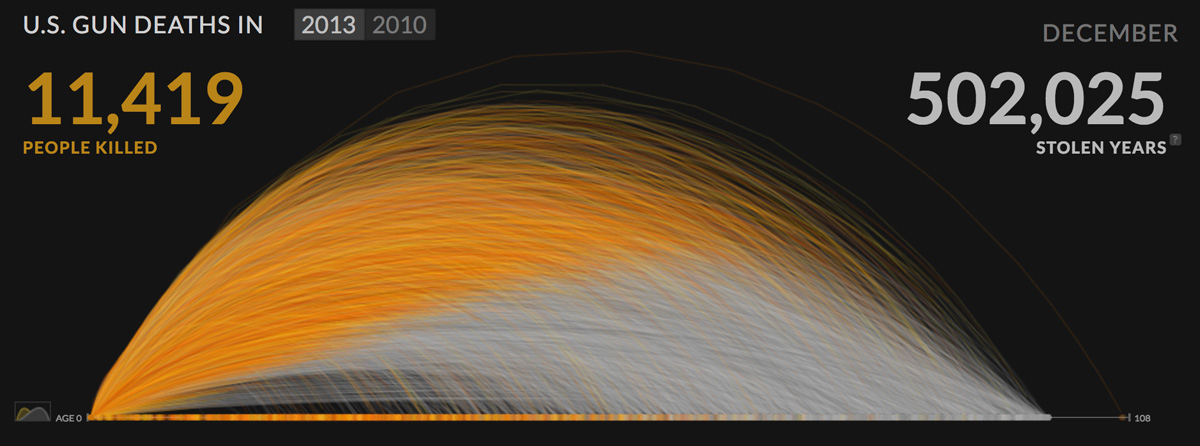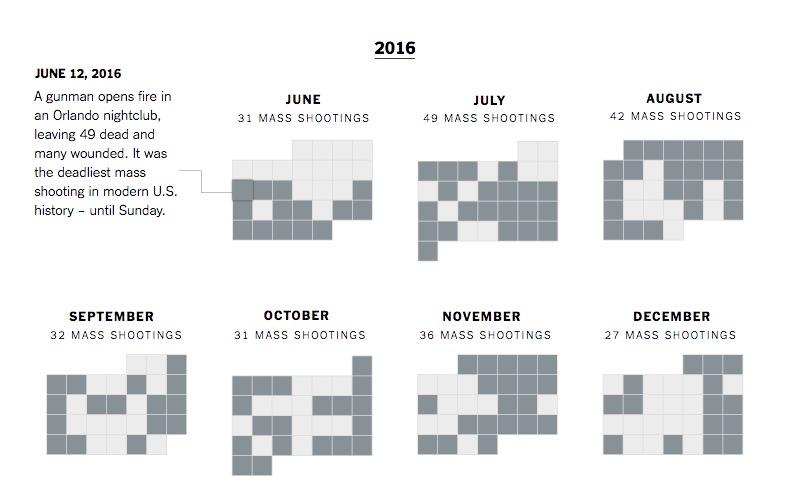Features:
Visualizing Mass Shootings
Two years of interactives and data on gun killings in the US
Over the past two years or so, we’ve kept tabs on our community’s work around guns in America. We’ve seen a wealth of data visualizations and a huge breadth of interactive projects that bring clarity to stories of gun violence and mass shootings—projects often assembled quickly amid the chaos of breaking news.
After the mass killing in Las Vegas this week, we’re sharing our collection of exemplary and challenging projects as resources to comb through now, and to turn back to when the next time inevitably arrives.
This work isn’t easy for anyone who does it. We salute the many reporters, editors, designers, data nerds, and developers who do it, thoughtfully and relentlessly, in the hope of angling us toward a future with fewer next times.
The Scale of Mass Killings

(Axios)
Coverage of victims often operates at two (opposite) distances. It shows us up-close portraits of the lives lost. Or it shows the enormous scope of the death toll. An often-linked Washington Post interactive, The Math of Mass Shootings, does both. As we publish this piece, the Washington Post piece tracks 949 deaths in the country’s deadliest modern mass shootings, beginning with the murders of 16 people at the University of Texas in 1966. The feature represents each ended life as a human figure with a name and an age, except for those killed in Las Vegas this week—their data is still coming in.
Since 2015, the Post has also been tallying and categorizing the deaths of every person fatally shot by police in the US—a monumental undertaking that shares many characteristics with the presentation of the Post’s mass shootings interactive.
The Gun Violence archive is “an online archive of gun violence incidents collected from over 2,500 media, law enforcement, government and commercial sources daily in an effort to provide near-real time data about the results of gun violence.” The archive defines “mass shootings” as those in which at least four people (besides the shooter or shooters) are injured or killed. Its data fuels the Guardian’s long-scroller chart of mass-shooting deaths and injuries in the US and Axios’ similar chart.
The Atlanta Journal-Constitution recently mapped a geospatial representation of mass shootings, based on data from Stanford University, and allows readers to filter mass shootings by the kind of guns used and by the shooter’s characteristics (age, gender, mental illness status) when known.
We also still think a lot about Periscope’s interactive visualization of US gun deaths in 2010 and 2013 as a series of stopped lives and a tally of stolen years.
While many interactives count lives, others are counting guns. This one in the New York Times, How They Got Their Guns, shows the parallel timelines of very different mass shootings. And over at Bloomberg, this is what a gun sales surge looks like. From Mother Jones, here’s another deep dive into dollars: a look at the cost of gun violence to American taxpayers.
Data and Context
FiveThirtyEight collected data from the CDC, the FBI, the University of Maryland, Mother Jones, and other sources to visualize the US’s 33,000 annual gun deaths. The feature notes that the three kinds of shootings that attract the greatest media attention—mass killings, terrorist attacks, and police killings of civilians—are not representative of the true tally of gun violence in the US. Maggie Koerth-Baker wrote an accompanying article to break down the implications of the data.
We’ve also bookmarked this repo from NPR, data analysis for Everytown’s database of mass shootings in the U.S. from January 2009 to December 2016. And here’s Mother Jones’s frequently cited data set, US Mass Shootings, 1982–2017.
At the Washington Post, Kevin Schaul put together an interactive to look at the ways differing definitions of “mass shooting” affect our understanding and representation of large-scale gun deaths in the US.
For information on how lawmakers voted, on guns and everything else, we regularly turn to this database by ProPublica.
Calls to Action
An interactive editorial in the Boston Globe, Make it Stop, is one we return to again and again, and it was updated yesterday with new information on the fight for (and against) an assault weapons ban, along with running statistics on the number and death toll of mass shootings since the previous ban expired.
And yesterday, the New York Times published a technically simple, visually striking graphic editorial marking the number of days in which at least one mass shooting occurred in the US since the Pulse nightclub shootings in 2016.
Harm Reduction
Since 1989 the CDC has issued guidelines for journalists covering suicides, offering a blueprint for reporting on suicide without needlessly increasing the “contagion” effect. The guidelines are clear and actionable, and few mainstream news organizations now report extensively on suicides. No equivalent guidelines for mass shootings exist—not because there is a lack of evidence that these murders are also contagious, but because the CDC is legally prohibited from studying ways to reduce gun violence.
Zeynep Tufecki, a sociologist known for her work on online movements, has written for the New York Times, and previously for the Atlantic, about journalists’ role in spreading—or suppressing—the contagion of mass killings. Her guidelines are simple and clearly stated:
After a rash of copycat suicides in the early 1980s, the Centers for Disease Control and Prevention issued voluntary guidelines for reporting on such events: Emphasize that help is possible, do not romanticize the act and do not report on details of the method. (Research shows that being able to imagine an act in specific terms makes it more likely that someone will carry out their plans.)
The media needs to adopt a similar sensible framework to covering mass killings. And in the age of social media, that also means changing our own behavior.
This doesn’t mean censoring the news or not reporting important events of obvious news value. It means not providing the killers with the infamy they seek. It means somber, instead of lurid and graphic, coverage, and a focus on victims. It means not putting the killer’s face on loop. It means minimizing or not using the killers’ names, as I have done here. It means not airing snuff films, or making them easily accessible on popular sites. It means holding back reporting of details such as the type of gun, ammunition, angle of attack and the protective gear the killer might have worn. Such detailed reporting can give the next killer a concrete road map.
Gun violence and mass shootings are some of the most traumatic events that journalists and technologists work on, and work through. On Source, we offer a list of practical tips for mental health in the newsroom, from a SRCCON session by Joel Eastwood, and the DART Center offers extensive resources on self-care and peer support and on responsible coverage of mass killings.
How You’ve Managed It
The makers of the Globe’s Make It Stop wrote for us about the lightning-fast sprint to put this piece together, made possible by lots of groundwork laid earlier.
For smaller teams looking to prep for quick turnarounds, we found a lot of practical guidance in Carla Astudillo’s Source article about creating re-useable templates that hook reporting and graphics together. She explains why, in the aftermath of the Paris shootings:
One of our breaking news reporters asked if I could create a graphic breaking down the identities of each suspect and their respective fates. It would have to be done quickly and be easily updated as news changed. If we’d had more resources on hand, this would’ve been no big deal. However, I could get it done quickly that day, or I could make it able to be easily updated in our content management system. I couldn’t do both.
We’re Listening
The last few years have produced far more features on mass shootings and gun violence than we can include here. We are, now and always, interested in hearing from you—about interactives or features you found especially compelling, about your experiences negotiating the ethical and logistical tensions intrinsic in coverage of mass killings, or anything else about this work that you’d like to talk about. Send us a note: source@opennews.org.
Credits
-
 Erin Kissane
Erin Kissane
Editor, Source, 2012-2018.
-
 Lindsay Muscato
Lindsay Muscato
Editor of Source from 2015-2020






